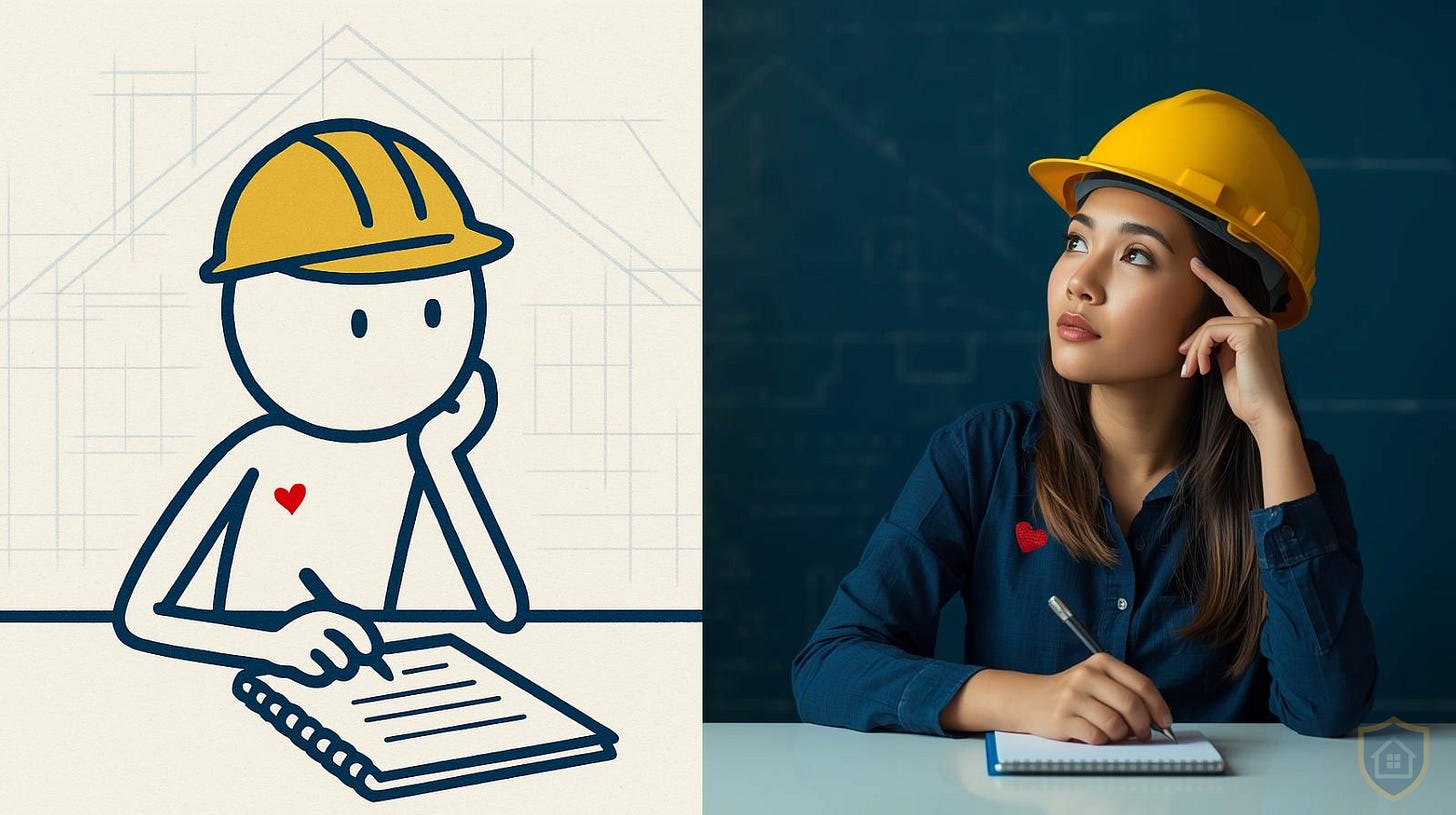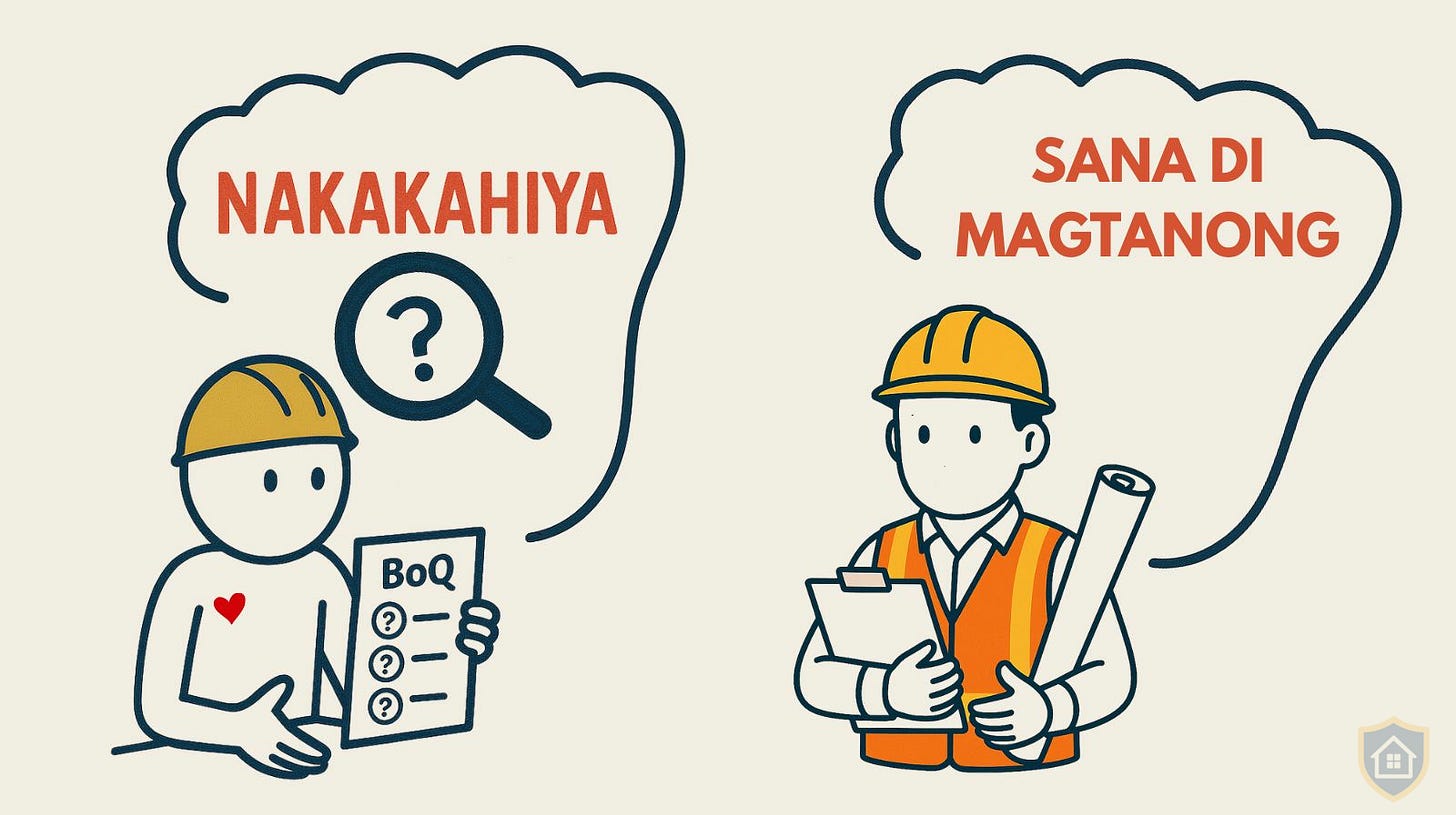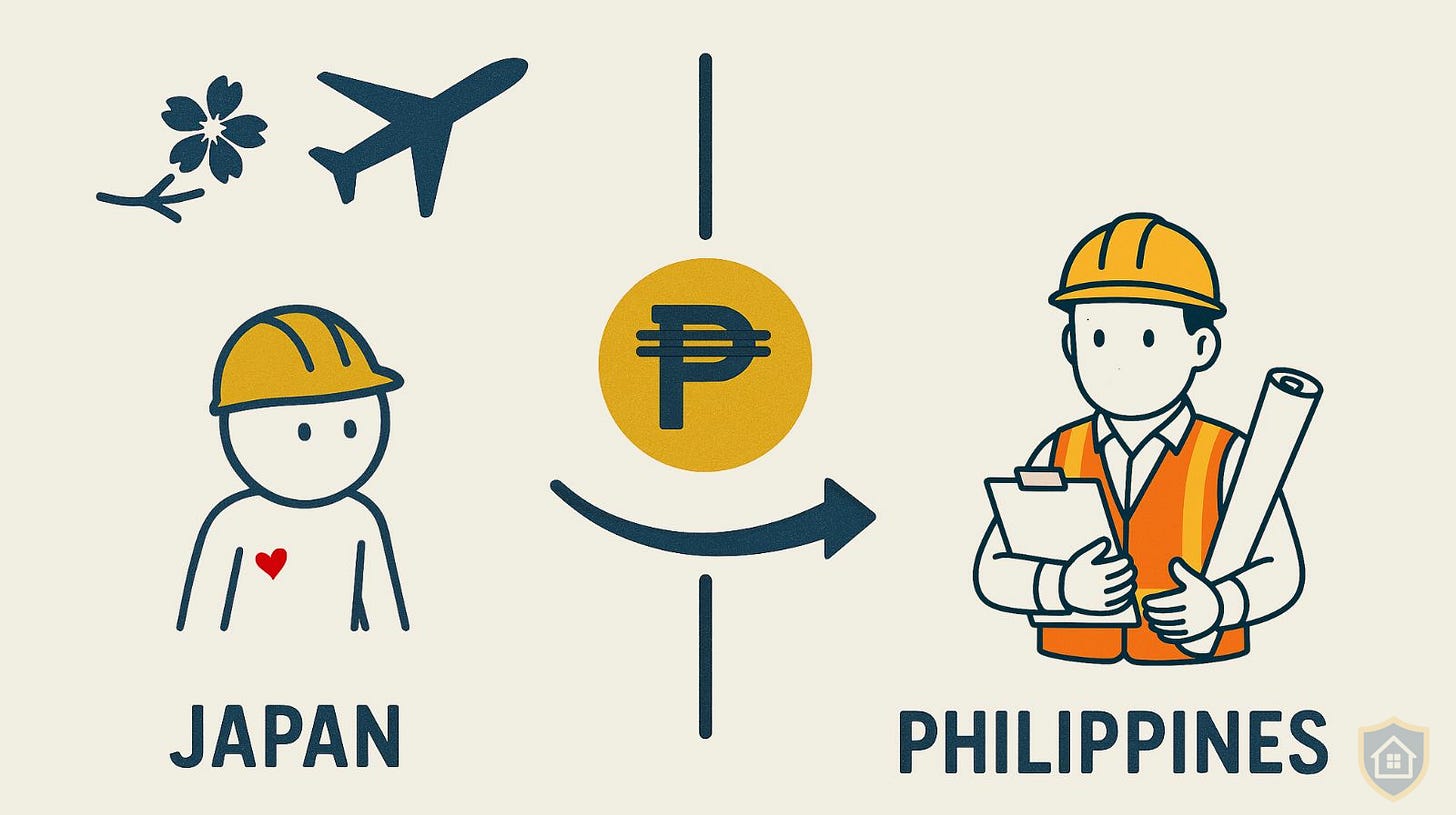The Questions I Should Have Answered Before Building a Home
Seven Hard Questions and Ten Actionable Steps Before You Build

I used to believe that when we entrust our home and money to a professional, they’d turn out to be good stewards with a high regard for integrity. We don’t have to worry because we’re relying on their expertise. We’re in good hands.
Sadly, that’s not how it always works.
The reason I got scammed wasn’t just because the engineer was dishonest. It’s because I made it easy for him. I trusted blindly in people’s good hearts, especially our kakilalas. I forgot that this world has another side.
It’s a moral cesspool.
We have this popular saying: “Kung walang magpapaloko, walang manloloko.” I disagree with this completely. This blames the victim, the one “nagpaloko,” instead of the scammer.
It should be: “Kung sana honest lahat, walang manloloko at maloloko.” But that’s not the world we live in.
Here’s what I learned: When I avoided honest reflection about this reality, I opened the door to deception. My blind spots were the weaknesses the “manloloko” exploited.
So before we dive into the technical aspects in future Dispatches, we start with ourselves. We close that gap by asking the hard questions we usually avoid.
Warning: These questions aren’t comfortable. They shouldn’t be. We’re protecting our investment, so we need to be brutally honest in answering them.
The Seven Questions
1. Why are you really building this house right now? Is it a genuine necessity, or are you tired of people asking, “Kailan niyo sisimulan ang paggawa ng bahay?” Or “Kailan ba matatapos yang bahay niyo?”
2. Are you building what you need, or what you want people to see? Is this about function or bragging rights?
3. Can you really afford this, or are you just proving you can? Can you sustain this budget, or are you banking on “bahala na” mentality?
4. What exactly do you want built, and can you explain it clearly? Bungalow? Two-storey? How many square meters? If you’re vague, someone else will decide for you.
5. How are you paying for this—savings or loan? And have you done the math? Did you calculate based on guesswork or actual costs?
6. Who’s really in charge of this project? Can you physically oversee this, or will you be managing from abroad? Distance is a scammer’s best friend.
7. What will you do when something goes wrong? Do you have a backup plan, or will you panic and just pay whatever they ask?
I didn’t answer them honestly, and it cost me and my family hundreds of thousands of pesos. (Want to know the specific tactics our engineer used? Read the full story in An Open Letter to Every Filipino Homeowner.)
Later in this Dispatch, I’ll walk you through my actual conversation with Inspector Milo, where he made me answer these questions one by one. But first, let me give you what you actually need: a clear action plan.
What You Can Do Right Now: 10 Actionable Steps
Whether you’re building now or just planning, these ten steps will protect you from making the mistakes I made.
1. Write down your answers
Answer all seven questions honestly. If you can’t clearly explain what you need and why, or if your answers are full of “pwede na siguro,” you’re not ready to build yet.
Take a notebook or open a document on your laptop. Write as if no one’s reading—include your fears, expectations, and pressures. Be honest about the difference between what you actually need and what you want to show off.
2. Set up your documentation system now
Digital or physical, with backup copies whenever possible. The first document you save? Your answers to all seven questions.
Create folders for everything: savings tracker, fund sources, loan requirements, research, quotes, contracts. When construction starts, add folders for receipts, photos, and messages. If you’re managing from abroad, require weekly photo and video updates and save them all.
No documentation = no payment.
3. Build your safety buffer into the budget from day one
Whatever total amount you have, don’t plan to spend all of it. Set aside 20% as your emergency buffer before you start.
If you have ₱1 million saved, your construction budget is ₱800,000 maximum. The remaining ₱200,000 stays untouched for unexpected costs.
Why? Because “unexpected” expenses aren’t unexpected—they’re guaranteed. Materials go up. You find structural issues. Someone measured wrong. Weather delays mean longer labor costs.
If you’re planning to spend every last peso, you’re setting yourself up to panic when problems arise. And that’s when you make desperate decisions.
4. Learn basic construction math
You don’t need any math-related degree here. Just know how to measure square meters and multiply. Get a tape measure. Measure your current space. Understand what 60 square meters actually looks like versus 85 square meters.
Learn the basic units: cubic meters versus square meters, bags versus individual pieces, or liters versus gallons. Understand when measurements refer to volume compared to area.
Scammers take advantage of you not knowing the difference. I remember a friend told me when I shared my story, “Ah, yun pala gamit ng lahat ng math na natutunan natin sa elementary hanggang college.” She’s absolutely right.
5. Research material prices yourself
Before anyone gives you a BOQ, spend a few hours online checking current prices for cement, steel bars, paint, tiles. Check multiple sources—hardware stores, online sellers, construction supply shops.
You don’t need to know everything, but know enough to spot when something’s wildly inflated.
If you’re too busy: It’s either you find a way to get this done or ask someone to do it for you. Price research is your first line of defense, so prioritize it.
6. Get three quotes, minimum
Never accept the first estimate. Get at least three from different contractors or engineers. Compare them line by line. If one is significantly higher or lower, ask why.
Big differences mean someone’s lying.
Don’t rely on the kakilala system. Look at results like portfolios, finished projects you can visit, or online photos you can double-check. If they rush you or dismiss your questions, walk away.
7. Practice saying “Let me verify that first”
Say it out loud right now. Get comfortable with this phrase: “Let me verify that first.”
You’ll need it when the contractor says materials suddenly cost more or when the engineer assures you, “Don’t worry, I’m transparent, here’s the BOQ.”
Just say, “Let me verify that first.”
And when you have questions, ask them, drop the “hiya.” So what if your questions sound basic or you think you look clueless? Their job is to explain. Your job is to understand and verify.
That “hiya” factor is exactly what scammers are counting on. They thrive when you hesitate to ask. So keep asking. Keep verifying.
8. Separate the roles—never give one person all the power
I made the mistake of letting the engineer handle everything: planning, oversight, purchasing, labor, and even receiving payments directly. That’s too much control with zero checks.
Better approaches:
Option 1: Engineer supervises + Contractor does labor + You control purchasing
Hire an engineer to create the BOQ and supervise. Hire a contractor to handle labor. You (or a trusted person) purchase all materials directly based on the engineer’s list. The engineer and contractor never control the money.
Option 2: Contractor does everything + Separate engineer inspects
Hire a contractor who handles labor and materials. Pay a separate, unrelated engineer to conduct regular inspections and verify the BOQ. The contractor and inspector check each other.
Option 3: You manage everything with the engineer’s guidance
Hire an engineer for the BOQ and periodic site visits only. You hire laborers directly, purchase materials yourself, and manage the project day-to-day. Only realistic if you’re physically present and have time.
The goal isn’t just verification. It’s the separation of powers. When one person controls everything, scamming becomes easy. When roles are split, everyone’s accountable to someone else.
For maximum protection: If you can’t be on-site (like OFWs), add a dedicated verification person on top of whichever option you choose. Give them a checklist of what to verify and when to call you. They report only to you, check the work independently, and confirm what the engineer or contractor says is accurate.
This should be a paid responsibility, not a favor. Yes, it costs extra, but it will protect you from much bigger losses.
Critical: This verification person should not be related in any way to the engineer, contractor, or anyone you’ve assigned to be in charge.
9. Write your “something went wrong” plan
Right now, before emotions get involved, create your three-level defense system:
Level 1: When do I pause payments? No regular updates, suspicious additional costs, not following specifications, no consultation on changes, missing materials, delayed work, too many excuses. Stop paying until issues are resolved.
Level 2: When do I walk away completely? Wrong measurements in the BOQ, inflated costs you can verify, repeated lies, no professionalism, zero transparency. Cut your losses and find someone else.
Level 3: What’s my maximum loss? Decide this now in concrete terms:
Amount: “₱50K maximum” or “10% of my total budget”
Time: “Two months of delays” or “three missed deadlines”
Stage: “Any major fraud before 30% completion = full stop”
Scenario: “One inflated BOQ discovered = maximum ₱100K to fix and finish elsewhere”
Have this ready before you need it. When you’re already invested, emotions will tell you to keep going. This plan reminds you when to stop.
10. Find your community
Join homeowner groups. Ask questions. Learn from others’ mistakes and from those who’ve survived scammers. Comment on posts or join discussion threads.
If you’ve survived construction fraud or have lessons to share, we want to hear from you. Email your story to constructionpulis.ph@gmail.com or join our Facebook page launching soon, where Inspector Milo will be sharing Real Talks and warnings.
You now have the roadmap. But I know some of you are thinking, “Easier said than done” or “How bad could it really be if I skip a few steps?”
Let me show you through Inspector Milo’s Real Talk.
This conversation happened AFTER I’d already been scammed, when I could finally see all the steps I’d skipped and the questions I’d ignored or answered dishonestly. If you want to see what that looks like in real time, keep reading.
If you’d rather skip the story and just use the checklist above, that’s fine too. The ten steps are your shield. This interview is just proof of why you need them.
Inspector Milo Interviews Kapwa Homeowner
Inspector Milo: Okay, real talk. Why did your family really start building? Genuine need, or dahil may pressure?
Kapwa Homeowner: My dad was also an OFW. When he finally settled in the Philippines, he had just enough money for the foundation. With the status of being “galing abroad,” he immediately began building without a plan. It was a show to prove something.
Ready ba siya? No. Parang may pressure na, “When are you going to build something on that bare land next to your old, small house?”
Inspector Milo: Yan ang problema sa Filipino culture, eh. Kung OFW, parang may pressure laging mag-prove. So noong ikaw na yung OFW, same thing ba? How did you handle yung pagtuloy ng construction? What you needed, or what people would say “wow” about?
Kapwa Homeowner: We applied for a loan in 2015 noong mas naging okay yung sahod ko sa China. Nagpa-blueprint kasi kailangan sa loan, pero never actually used it.
People said, “Wow, ang laki,” but for me, it doesn’t look good. Frankenstein house siya, iba-iba ang configuration bawat floor tapos “sagad” pa to maximize space.
Inspector Milo: Sagad lahat? How many square meters yan?
Kapwa Homeowner: Two hundred thirty.
Inspector Milo: And how much did you actually need?
Kapwa Homeowner: If we follow yung 60 square meters for each floor, then 180 is okay.
Inspector Milo: So binuild niyo yung hindi niyo kailangan. Paimpress? Okay. Let’s talk money. In 2015, could you really afford it, or bahala na lang?
Kapwa Homeowner: Maybe it’s not about paimpress, but it’s more about my family didn’t know what they were doing at that time. Kung afford? It’s the “bahala na” mentality. We borrowed based on guesswork. Ni hindi ko nga maalala kung may BOQ, so let’s just say naive talaga kami.
Inspector Milo: Talagang guesswork siya, kasi blueprint at BOQ yan talaga dapat muna. And that’s why you ended up with what—semi-finished floors?
Kapwa Homeowner: Yes. Semi-finished third floor, two incomplete shells.
Inspector Milo: Classic. Okay, fast forward to 2025, sa Japan ka naman na work? You hired the engineer. You got a BOQ this time. Surely you questioned the estimate, right?
Kapwa Homeowner: Yes, noong naging mas open na ang Japan for Filipino teachers, I applied in 2020, kasagsagan ng COVID, kaya delayed yung alis namin. I came to Japan na October 2021.
Anyway, when the engineer sent his estimate, it was expensive, but between my savings and my brother’s, we could afford the first floor. He’s also an OFW. I even tried to convince my brother to sacrifice most of our salaries for the second floor para ma-follow yung timeline.
Inspector Milo: Wait, sacrifice MOST of your salaries? For construction?
Kapwa Homeowner: Yes. But eventually when we talked, hindi namin kakayanin, so ang kaya lang ay yung first floor muna. Then we decided na, wait muna kami ulit ng ilang months bago simulan ang second floor para mas maluwag yung saving period. And we shared this with the engineer.
Inspector Milo: At least may common sense kayo na huwag magpumilit. But even with that plan, and you shared it pa with the engineer, you still didn’t question the price itself?
Kapwa Homeowner: I didn’t ask questions because I was being prideful and trusting. Yung tipo bang, nakakahiyang iask. I know, it’s stupid of me to think that way.
Inspector Milo: Ouch. How much did that pride cost you?
Kapwa Homeowner: More than I want to admit. More than we should have lost.
Inspector Milo: Mahal ng pride, ano? Sige, next question. When you started building, did you know exactly what you wanted? Like, clearly?
Kapwa Homeowner: We never sat down as a family to plan clearly. We didn’t know really what we wanted, so “they” decided for us. Square meters pa nga lang hindi namin alam in the first place.
Inspector Milo: Because you were vague or clueless, easy target. Sila na parang in-charge ng bahay at pera niyo. Sige, back to the money. You mentioned a loan in 2015 and savings in 2025. Did you actually do the math either time?
Kapwa Homeowner: We didn’t do any of that. Not to mention pala na before 2015, I’d been adding sa monthly remittance para sa pagtuloy ng construction, nanghiram pa kami kay tita, kapatid ni dad. Dahil walang plan at BOQ, parang naging doble-doble ang gastos. So, parang ang aking China income ay sa being breadwinner at sa bahay na parang walang nangyari.
Yung 2015 loan, many years we paid only the interest, money drain siya. Then around 2022, we aggressively paid for it para matapos na. Kaya noong 2025, we thought time naman to finish yung building. We didn’t do the math kasi akala namin yung BOQ ni engineer ay tama, yun lang, we didn’t verify.
Inspector Milo: Masaklap. Dito natin makikita kung gaano kaimportante ng may plan at BOQ. Kasi kahit paunti-unti, kung alam mong may sinusunod ka, may direction and kung may direction, may matatapos. Okay, who was in charge of the project? 2015 versus 2025?
Kapwa Homeowner: Si dad yung pinaka in-charge noong 2015 na clueless. Ako naman ngayong 2025 na super trusting. I even asked my family not to interfere this time, kasi nga may hired na expert na engineer na scammer pala.
Inspector Milo: That’s why it matters kung sino ang in-charge and kung sino ang bantay. Since you’re in Japan, how were you managing this?
Kapwa Homeowner: Video calls, messages, photos. I trusted the engineer completely. Diretso pa nga sa account niya yung pera.
Inspector Milo: Distance plus trust equals opportunity for scammers. Did you have anyone verifying his work?
Kapwa Homeowner: No. Lahat ng usapan between the two of us lang. But with the cracks observed, that’s the time I got my family involved. I know ito talaga yung big mistake ko kahit na trusted ko si engineer, dapat I asked my family to be directly involved para may accountability. Dapat may copy rin sila nung BOQ. Hay.
Inspector Milo: Hay nako talaga. The good thing is, first floor lang. Last question, and this is important: when things started going wrong, yung mga cracks and the big reveal you mentioned in your Open Letter, did you have a backup plan?
Kapwa Homeowner: I had no backup plan. When the cracks began to show, I kept hoping he’d fix things. I was trapped by sunk cost. Nasend ko na ang 90% ng first-floor budget. Buti nahold ko pa yung 10% para sa windows at cabinet. My parents took over dealing with the windows, and we found our own carpenter for the cabinets.
I shared my suspicions with my brother noong una-una, but we’re all like, “Impossible namang magagawa niyang lokohin tayo.”
Inspector Milo: Ay gusto yan ng mga scammers, yung paniwalang-paniwala ang victim na hindi na nagdududa. Buti may 10% pa palang nailigtas. So what saved you from even bigger losses?
Kapwa Homeowner: Yung mode of funding, yung paggamit namin ng savings. The staged funding limited how much he could take. So imagine if we took out a loan again for the first and second floors and followed the timeline, double ang losses. May nawala nang pera tapos babayaran pa namin yung interest sa coming years. So I’m grateful for how God intervened.
Inspector Milo: At least may silver lining. So what will you do now?
Kapwa Homeowner: After finishing my contract in Japan, I’m going back to the Philippines to oversee the second floor myself at aayusin din yung third floor. It helps that my brother is my partner in this, at siya naman ang breadwinner since I left China. It makes it possible para makauwi na muna or maybe even settle para ayusin din lang ang rental pag tapos na lahat.
I know not everyone can just go back to oversee, especially solo breadwinners. But there’s always a way to minimize or completely avoid scams, and that is by answering all seven questions honestly and following the ten steps mentioned in this Dispatch.
Inspector Milo: There it is, Kapwa Homeowners. You heard it straight from someone who learned the expensive way. Pride, pressure, vagueness, no backup plan. Every blind spot became an opening for the scammer.
The seven questions and ten steps are not optional. Wag tamad sagutin at gawin, or else your story becomes another version of this na hundreds of thousands down the drain. Ayaw niyo naman siguro ng ganyan, ano?
The warnings are here. Para walang palusot. 🐾
Do Your Homework
Be your own Construction Pulis.
Know a fellow OFW or homeowner who needs to read this? Forward this Dispatch. Together, scammers don’t stand a chance.





